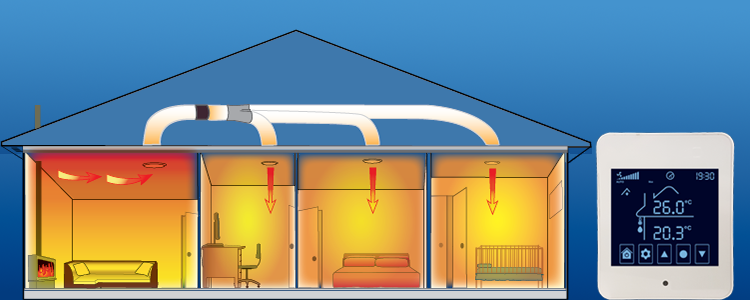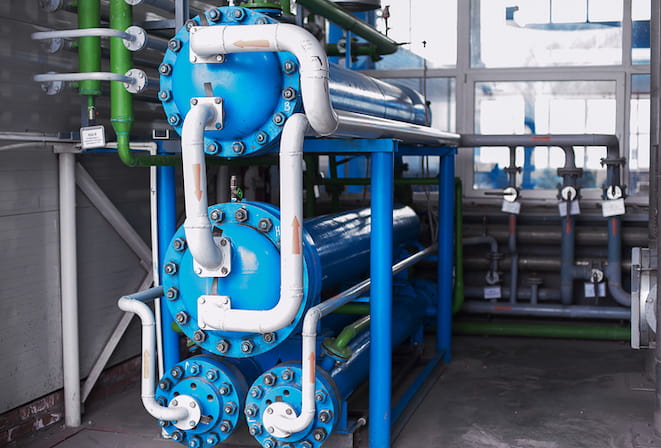How DVS Heat Transfer Systems Are Redefining Energy Efficiency in Industrial Cooling
Wiki Article
Technologies in Heat Transfer Systems: What You Required to Know for Ideal Efficiency
Technologies in Heat transfer systems are changing efficiency across numerous industries. Advanced products like graphene and nanofluids promise substantial enhancements in thermal conductivity. On the other hand, the combination of IoT and artificial intelligence supplies chances for real-time monitoring and boosted power effectiveness. Nevertheless, the landscape of thermal monitoring is rapidly advancing (DVS Heat Transfer Systems). Recognizing these advancements is vital for achieving excellent system performance and sustainability in the future. What specific advancements are forming this transformation?Emerging Materials for Boosted Heat Transfer

Advanced Heat Exchanger Styles
While traditional Heat exchangers have served their purpose in different applications, advanced designs are currently arising to satisfy the increasing needs for performance and performance. These innovative layouts, such as plate, shell-and-tube, and finned-tube Heat exchangers, incorporate improved area and enhanced flow patterns to increase thermal transfer prices. Furthermore, portable designs permit minimized room demands without jeopardizing effectiveness. Advanced materials, such as composites and corrosion-resistant alloys, additionally enhance toughness and performance under extreme conditions. Additionally, simulation innovations and computational fluid characteristics are significantly used to refine these styles, guaranteeing peak Heat transfer characteristics. As markets seek to decrease power consumption and maximize output, the fostering of advanced Heat exchanger layouts is critical in achieving these objectives.The Duty of Nanotechnology in Heat Transfer
Nanotechnology plays a vital duty in boosting thermal conductivity within Heat transfer systems. By adjusting materials at the nanoscale, researchers have attained significant enhancements in energy effectiveness. These developments not only maximize efficiency yet additionally add to more lasting power remedies.Boosted Thermal Conductivity
Considerable advancements in thermal conductivity have arised via the application of nanotechnology, transforming Heat transfer systems across different sectors. By incorporating nanoparticles right into Heat transfer liquids and products, scientists have accomplished exceptional increases in thermal conductivity. These nanoparticles, such as carbon nanotubes, graphene, and metal oxides, boost the Heat transfer buildings as a result of their high area and distinct thermal features. The resulting composites show boosted efficiency in applications ranging from electronic devices cooling systems to eco-friendly power modern technologies. The ability to tailor the dimension, shape, and composition of nanoparticles allows for maximized thermal administration remedies. Because of this, nanotechnology continues to play an essential duty in the development of extra efficient and efficient Heat transfer systems, paving the way for improved industrial applications.
Power Performance Improvements

Assimilation of IoT in Heat Transfer Equipments
The combination of IoT in Heat transfer systems introduces the execution of smart sensing units that boost operational performance. These sensing units make it possible for real-time data surveillance, enabling for immediate adjustments and optimizations. This technological innovation has the possible to significantly improve efficiency and energy about his administration in Heat transfer applications.Smart Sensors Execution
As Heat transfer systems evolve, the assimilation of smart sensors via the Web of Things (IoT) has actually become a transformative strategy. These sensors enable real-time surveillance of temperature level, flow, and pressure rates, improving system efficiency and reliability. By accumulating and sending data, they facilitate positive upkeep, lowering the threat of system failures. Additionally, smart sensors add to power savings by refining functional specifications based on environmental problems. Their ability to assess patterns and anomalies permits educated decision-making, making sure peak performance of Heat transfer systems. As sectors progressively adopt this innovation, the application of clever sensors stands to reinvent just how Heat transfer systems are handled, leading the means for greater sustainability and improved performance outcomes.Real-Time Information Surveillance
Just how can real-time information monitoring improve the efficiency of Heat transfer systems? By incorporating Internet of Things (IoT) technology, Heat transfer systems can leverage constant information collection from smart sensors. This real-time monitoring permits prompt evaluation of temperature, stress, and flow rates, allowing drivers to identify inadequacies without delay. Adjustments can be made to maximize efficiency, reduce check that energy usage, and expand equipment lifespan. In addition, anticipating maintenance can be carried out, decreasing unforeseen downtime and pricey repairs. The capability to visualize efficiency metrics through dashboards boosts decision-making, cultivating a proactive approach to system monitoring. Eventually, real-time information keeping track of not just improves functional performance but additionally adds to sustainability objectives within commercial processes.Energy Effectiveness and Sustainability Trends
Energy efficiency and sustainability patterns are improving the landscape of Heat transfer systems, driving technology and conformity across various industries. Organizations are significantly prioritizing energy-efficient layouts to lower operational prices and decrease environmental impacts. The assimilation of sustainable power resources is coming to be much more common, making it possible for Heat transfer systems to operate sustainably while satisfying regulative needs. In addition, innovations in modern technologies and products advertise lower energy intake and enhance general efficiency. Lifecycle analyses are also getting traction, permitting companies to assess the environmental effect of Heat transfer systems from production to disposal. This focus on sustainability not just sustains corporate obligation however additionally positions organizations competitively in a market where customers increasingly prefer environmentally friendly solutions. Power efficiency and sustainability remain crucial factors to consider for future growths in Heat transfer technology.Technologies in Thermal Administration Solutions
While the demand for effective Heat transfer remains to rise, technologies in thermal monitoring remedies are arising to address both efficiency and sustainability challenges. Advanced products, such as phase modification products and nanofluids, are being established to improve Heat transfer effectiveness - DVS Heat Transfer Systems. These materials enhance thermal conductivity and allow for far better temperature regulation in numerous applications. In addition, innovations like active thermal control systems are obtaining grip, enabling real-time adjustments to handle Heat circulation effectively. These systems this add to energy savings and lower the environmental influence of thermal procedures. Moreover, the assimilation of IoT in thermal management promotes tracking and anticipating upkeep, guaranteeing optimized efficiency and longevity of Heat transfer systems. Generally, these technologies stand for substantial strides towards even more lasting thermal administration methodsFuture Directions in Heat Transfer Innovation
Arising advancements in thermal management options indicate a promising future for Heat transfer innovation. Researchers are significantly focusing on developing products with exceptional thermal conductivity and improved energy performance. Innovations such as nanofluids, which include put on hold nanoparticles, supply substantial renovations in Heat transfer performance. In addition, the combination of clever products that adapt to varying temperature conditions is gaining traction, enabling more reliable and receptive systems. The rise of additive production techniques is also enabling the style of complicated Heat exchanger geometries that maximize liquid circulation. The application of device learning formulas is anticipated to change the optimization of Heat transfer systems, promoting anticipating upkeep and efficiency enhancement. Collectively, these innovations are positioned to transform the landscape of Heat transfer modern technologies in numerous industries.
Regularly Asked Questions

Exactly how Do I Select the Right Heat Transfer System for My Application?
Choosing the best Heat transfer system entails assessing application demands, consisting of temperature varieties, liquid buildings, and efficiency needs. Assessing system types, maintenance factors to consider, and cost-effectiveness additionally plays an essential function in making an informed decision.What Are the Maintenance Needs for Advanced Heat Exchangers?
Maintenance requirements for innovative Heat exchangers usually consist of routine examinations, checking for leaks, cleaning of surfaces, and ensuring excellent flow prices. Sticking to producer standards guarantees efficient procedure and prolongs the devices's life expectancy.
How Do Ecological Variables Influence Heat Transfer Effectiveness?
Environmental variables significantly affect Heat transfer efficiency. Variations in temperature, airflow, and humidity impact thermal conductivity and convective Heat transfer, eventually affecting system performance and necessitating consideration during the style and operation of Heat transfer systems.What Safety And Security Specifications Put On Heat Transfer Solutions?
Safety standards for Heat transfer systems normally consist of guidelines from companies such as ASME and ASTM. DVS Heat Transfer Systems. These criteria address products, design, and operational methods to ensure dependability, efficiency, and defense against risks in different applications
Exactly How Can I Troubleshoot Common Heat Transfer System Issues?
Repairing typical Heat transfer system issues involves checking for leaks, making certain correct fluid circulation, evaluating insulation stability, and verifying temperature differentials. Recognizing these aspects can assist preserve system effectiveness and protect against additional problems.Nanotechnology plays a necessary function in enhancing thermal conductivity within Heat transfer systems. Significant improvements in thermal conductivity have arised through the application of nanotechnology, reinventing Heat transfer systems throughout different markets. Improvements in thermal conductivity via nanotechnology have actually paved the way for exceptional enhancements in energy effectiveness within Heat transfer systems. Energy effectiveness and sustainability trends are improving the landscape of Heat transfer systems, driving development and compliance throughout different sectors. The combination of IoT in thermal administration assists in surveillance and predictive upkeep, guaranteeing optimized efficiency and long life of Heat transfer systems.
Report this wiki page